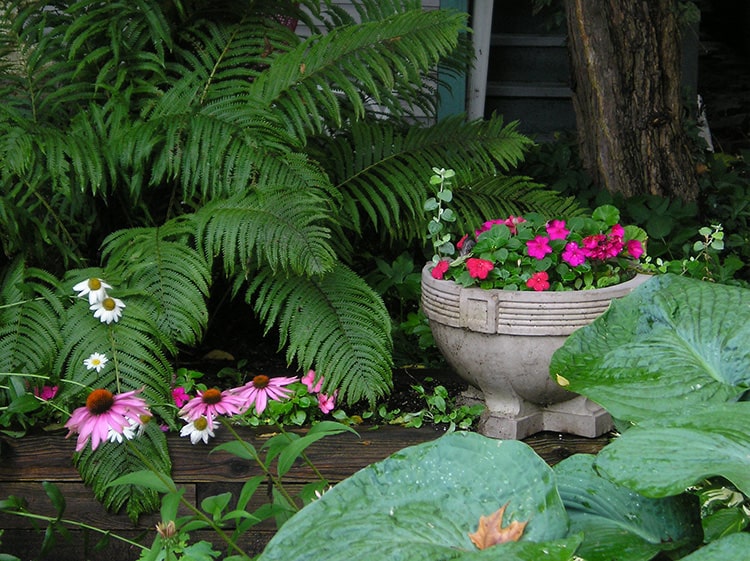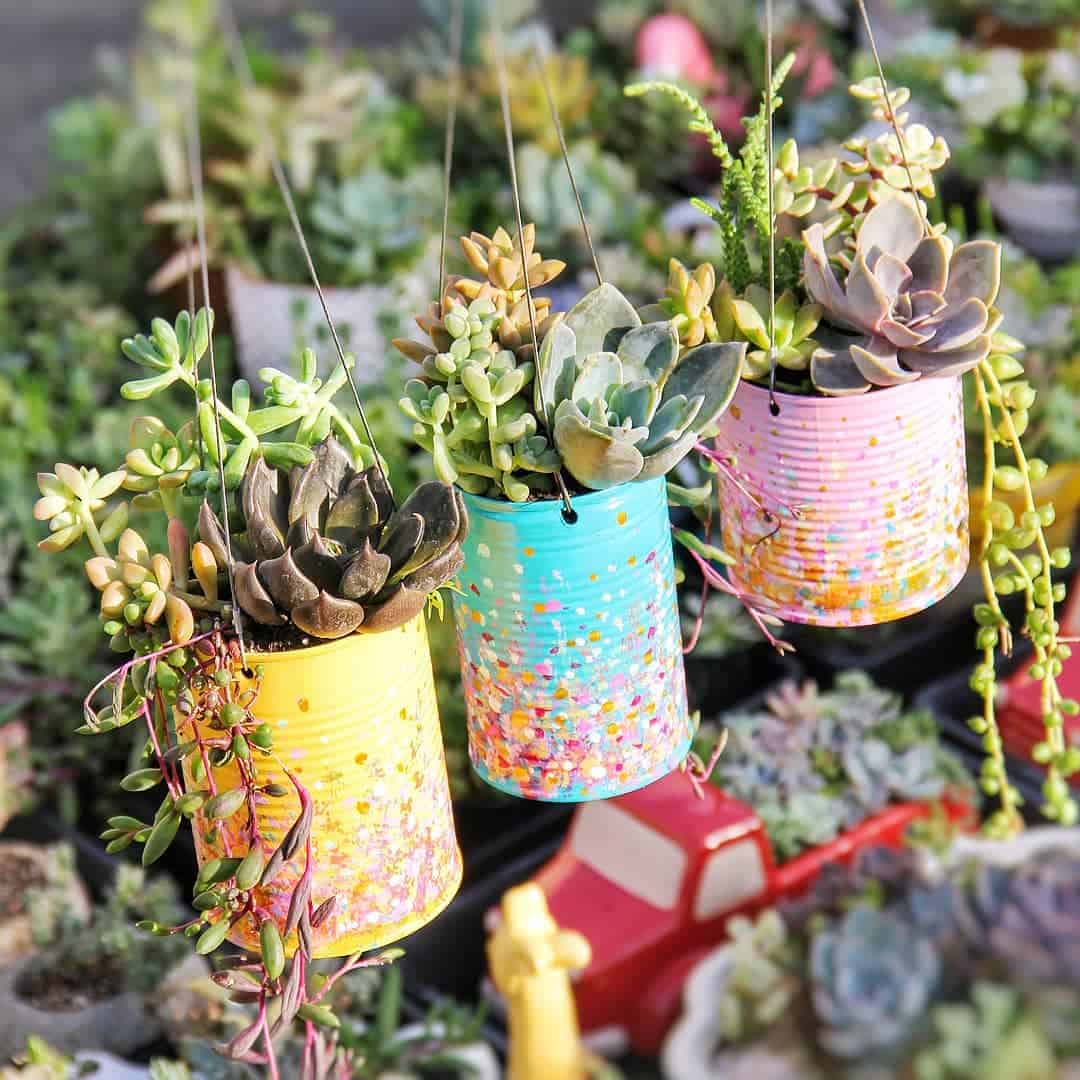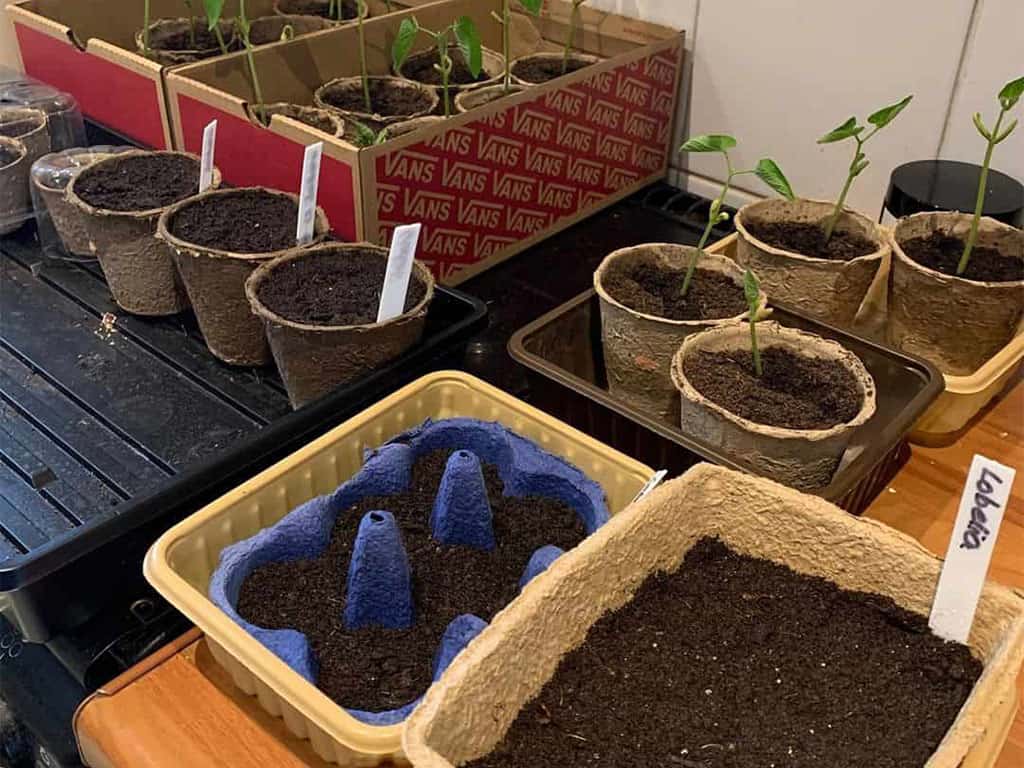Hanging baskets are a beautiful way to add colour and interest to your garden, especially if you’re short on space. They add a new dimension to balconies, terraces and patios, and can look beautiful dotted along a fence, or on either side of a doorway. These hanging basket tips and tricks are perfect for prepping, planting and positioning your first hanging baskets!
If you’re looking for ways to introduce plants to a lawn-free garden, shady side-garden or minimalist, low-maintenance space, hanging baskets are an incredibly versatile way to do so. They’re also ideal for rental gardens, or if you’re hoping to sell your home, as you can simply take them with you when you move.
What else is good about hanging baskets? Well, you can use them for different plants throughout the seasons – even for vegetables – to provide beautiful greenery from spring, through summer and right into winter. Even when the rest of your flower beds are looking a bit sad in winter, these hanging basket tips will help you create gorgeous displays to decorate your garden.
Hanging Basket Tips: Basket Styles
Hanging baskets come in lots of materials, styles and sizes, and picking the right one for your garden is about more than just aesthetic.
Aim for baskets that are at least 38cm across. Small baskets will dry out much faster in hot weather, and plants won’t be able to grow big enough to make a dramatic impact. Bigger baskets allow you to grow a greater variety of flowers for your display, and will retain water better.
Hanging baskets are usually available in three different styles:
- Rattan baskets with a plastic liner to hold water
- Wire mesh baskets which allow you to grow plants at the sides
- Plastic baskets that are good for protecting plants against the elements
The first of my hanging basket tips is definitely to think about the style of your basket in combination with the plants you want to put in it – the decisions will affect each other very much.
When should you plant a hanging basket?

Are you planning a summer hanging basket, a winter hanging basket, or a perennial hanging basket?
For summer blooms, prepare your baskets in a shed or greenhouse in April, moving them outside in May (after the last frost). If you don’t have a shed, you can begin planting in May and your flowers should still get established in time for summer.
Winter hanging basket tips: start preparing yours in late September/October. You don’t have to worry about frost so much, as the plants in your winter baskets should be hardy enough to tolerate the cold.
Perennial baskets can typically stay up year-round, but check the kinds of plants you’re using and be prepared for some maintenance and refreshing between seasons.
Hanging Basket Tips: Choosing Plants
The most impressive hanging basket displays use a combination of plants to create height, width and depth. Use taller plants in the centre, surrounded by bedding plants, with creepers and trailing plants positioned to cascade down the sides.
The best plants for summer hanging baskets are clusters of petunias, geraniums, fuschia and pansies, combined with creeping jenny and silver falls for downward growth.
In a winter basket or perennial basket, try ivy, box shrubs, winter pansies, ornamental sedge and heathers. You can also try herbs, like rosemary, sage and thyme. Mint will also grow happily in a hanging basket – but it will also take over and potentially smother any other plants.
When you’re buying plants, check their labels for hanging basket suitability. Choose a few scented flowers for a gentle aroma around your garden, and look for long-flowering varieties to enjoy them throughout summer.
Preparing a hanging basket
The basic steps to creating a hanging basket for winter and summer are the same. You may even want to have two sets of baskets, so as soon as your summer flowers begin to die, you can swap in your winter set.
Step 1: Lining the basket
Wire baskets and rattan baskets need to be lined (although most rattan baskets are pre-lined). Start by standing your basket in a bowl or pot to stop it from rolling around. You can buy purpose-made liners made from plant fibres or cardboard, but you can also use moss from shady spots in your garden.
Step 2: Watering tips
Hanging baskets will dry out more quickly than containers or soil, so prepare ways to help yours retain water. For example, adding a plastic disc or saucer at the bottom to stop water from seeping straight through.
When you’ve filled the basket with compost (more on that in a moment), you can also submerge a small, empty, flower pot in the centre. Rather than watering the surface of the basket and letting it all roll off, pour water into the pot and it will slowly seep out through the bottom into the soil.
There is such a thing as ‘self-watering’ baskets, which have a separate water reservoir that gradually feeds water back into the plant roots. This type of basket won’t need watering as frequently.
Step 3: Compost tips
If you only remember one of these hanging basket tips, make sure it’s this: invest in a good quality compost. One of the main challenges when it comes to keeping hanging baskets healthy is preventing water and nutrients from just draining out the bottom. The methods we just looked at will help, but the right compost is important too.
Choose a peat-free compost from a well-known brand, and combine it with slow-release fertiliser granules. Add a layer of water retaining gel crystals about 10cm above the base of the basket so that the soil doesn’t dry out so quickly.
Hanging Basket Tips: Planting Your Flowers
Whether you’re planting for winter or summer, there are a couple of hanging basket tips for creating the best display.
The simplest arrangements have just one kind of plant or flower overflowing from the basket. This works well if you have several hanging baskets that all look similar, creating a pattern.
If you’re relying on just one or two hanging baskets to create visual impact, you’ll probably want to fill them with a combination of colours, shapes and textures. Depending on the size of your hanging basket, you’ll need 1-3 plants for the centre, 3-5 brightly-coloured plants for the middle and 6-9 trailing plants to spill over the edge. Wire mesh baskets can support more plants poking through the sides.
Start planting in the centre, with a plant that has good structure and height to grow above the others. Surround this with shorter leaves or flowers to add bushy texture and colour. Pick a mixture of colours for the most cheerful display. Finally, add trailing plants around the edge to cover the sides of the basket.
Hanging Basket Care
Looking after hanging baskets after they’re planted is fairly straightforward. The main thing to keep an eye on is moisture, especially in hot weather. In sunny seasons, water them every day unless the soil is still wet, and check the soil every few days in winter (the solid should stay damp, but not soaked).
The best ways to check this are to lift the baskets to see if they’re heavy with water, or to press a finger into the surface of the soil (if compost clings to it then there’s a good level of moisture). If your flowers start to wilt, water them thoroughly and catch the run-off in a bucket or bowl underneath so you can return those nutrients to the soil next time you water.
You can also add liquid fertiliser to your water during the growing season – usually spring to early autumn, while the weather is warm. Deadheading (pinching off dying flowers) will encourage most plants to produce new flowers and keep your hanging baskets looking pretty for longer.
When it gets to the end of the season and most of your hanging basket is dying off, you can gently separate survivors and plant them in pots or in your garden. The rest of the basket can be used for compost.
Identifying Problems with Hanging Baskets
Are your baskets looking a bit sad, or have they stopped flowering altogether?
Underwatering is usually the problem with hanging baskets as they dry out just so darn quick. When they get too dry, the soil can actually become hydrophobic, making the problem even worse. If water just runs straight off the soil, you’ll need to find a way to soak the basket for half an hour or so to re-hydrate. Generally, it’s best to water your hanging baskets a little bit every day.
If you’re certain that under-watering couldn’t possibly be the problem… have you considered that you might be overwatering them? Each time water runs out the bottom of your hanging basket, it takes precious soluble nutrients with it. Eventually, there’s no good stuff left in the soil, and your plants begin to suffer. Hold back on the watering and add some of the nutrients back with fertiliser every week or so.
What if you’re already fertilising your plants, but they’re still looking peaky? Make sure your fertiliser is properly diluted according to the instructions, and that your soil is already moist when you add it so that the plant roots don’t get damaged.
It’s time to go!
You can usually get all the hanging basket supplies that you need from a garden centre or DIY store. Of course, you can also use your own compost and existing plants from your garden, providing they’re the right type.
These beautiful flower displays really are a stunning way to add plants and colour to a small area, and hopefully with these hanging basket tips you’ll be able to grow happy, healthy displays all year round.

Save this pin for later














